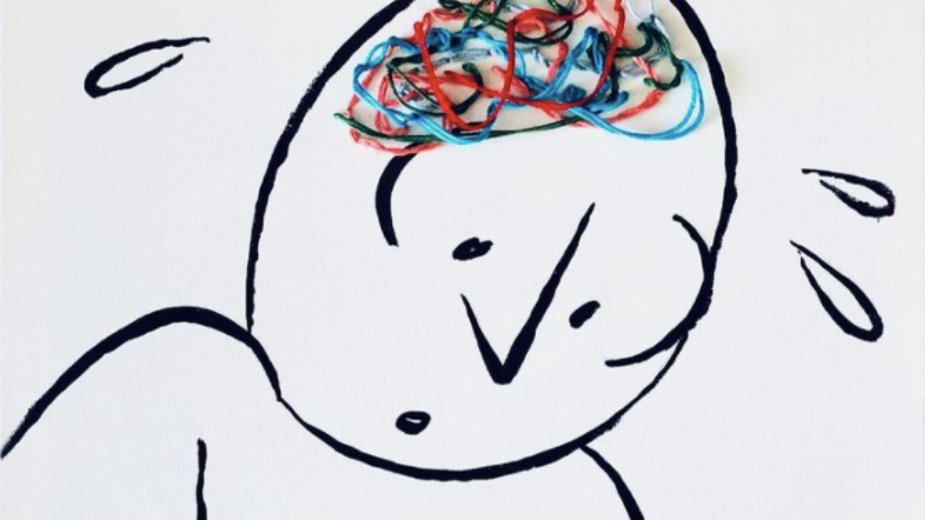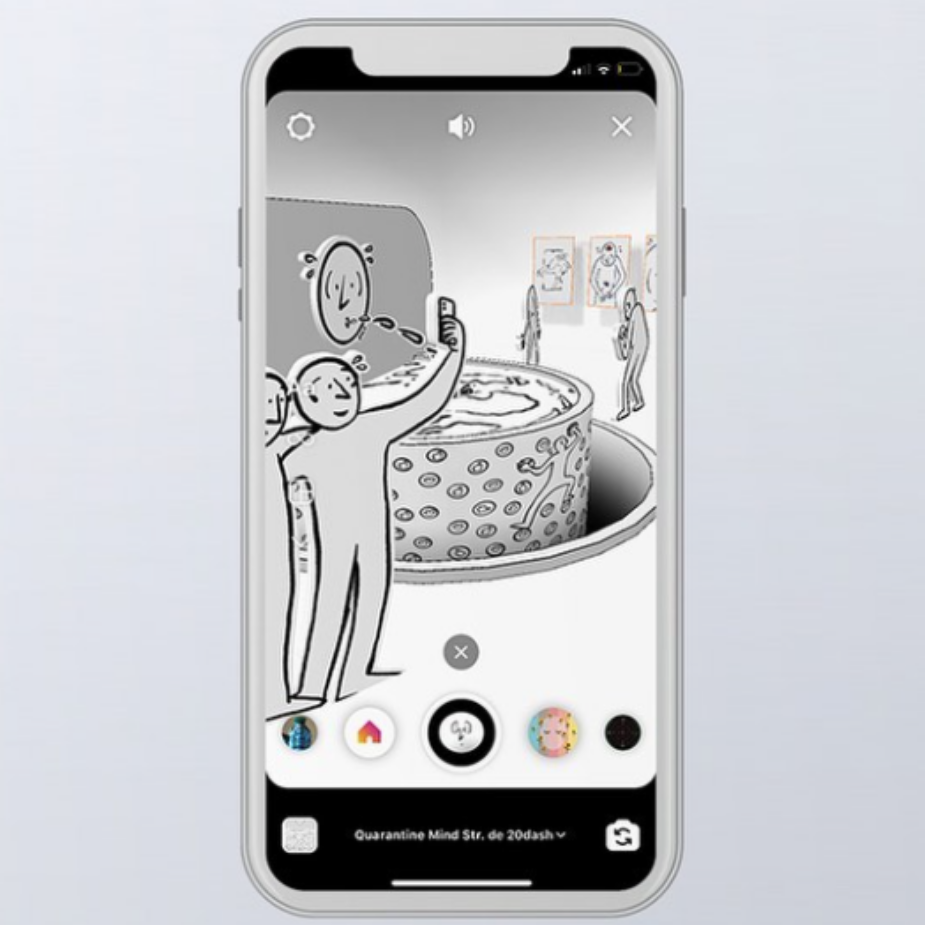
Meet Suadinho, the Stressed-Out Stickman Who Shows ECDs Can Benefit from an Artistic Outlet

Sweaty, anxious, constantly stressed. If ever a character encapsulated the experience of 2020, it’s Suadinho.
The line drawn figure is the brainchild of executive creative director André Gola, who dreamed him up in 2013. Over the years the nervy little dude (whose name is the Porrtuguese for ‘sweaty’) has picked up a huge following on Instagram and Giphy. As André worked with Suadinho, he found that the twitchy little dude became a way for him to understand his own negative emotions, even interpreting and dealing when he was diagnosed with hydrocephaly.

But there’s something about the jittery little figure that also encapsulates the experience of being stuck at home and inside one’s own head that has come to be near universal in the year of the Covid-19 pandemic. That’s why this summer André turned his Suadinho artwork into ‘Quarantine Mind’, an augmented reality exhibition that people can visit through their phone camera and the Instagram app. The experience was developed in conjunction with Denis Shirazi, the developer of 20DASH, André Wissenbach who helped him render the project in 3D and Facebook/Instagram's Daniel Bottas to help make the most out of the tool. Denis had been inspired by filters used to pay tribute to George Floyd but wanted to make an experience that was surreal, spontaneous and playful. Andre Gola saw an opportunity to raise money for the mental health institute Ame Sua Mente and Instituto Projeto Sonhar, which supports many people living in a poverty-stricken community in São Paulo. (To visit the virtual exhibition, open this link on your smartphone.)

With Suadinho finding new audiences and inspiring followers around the world to use creativity to explore their own psychology and mental health, LBB’s Laura Swinton caught up with André to find out more about Suadinho and why, as an advertising creative, he finds such value in having a purely artistic creative output.
LBB> Tell me about your wonderful line drawings and the permanently anxious character you depict, Suadinho - who is he, how long have you been drawing him - and what inspired him?
André> Thanks for your kind words. Suadinho the character came about in 2013 as I was working on my advertising rough sketches. It was my peer and friend, Pernil, who first encouraged me to post it on social media. Soon came the support of some other friends, whose critical judgement and understanding of art I deeply respect, and then the favourable response from people who followed me because they knew my work in advertising. That gradually inspired me to express my own thoughts openly through my drawings.
LBB> How did you develop his look? And why did you end up drawing him in this deceptively simple style?
André> I've always found this "stick figure" to be a way to give my ideas some human form. I'm a real fan of artists who are able to come to a synthesis of a myriad of things within just a few lines or words. It is as if simple images harbour a host of invisible layers underneath them and, as you get to connect with them, you begin to see them within you. I used to have so much fun devouring the cartoon section of the New Yorker Magazine, for example.
Many of their cartoons rely on a caption to help readers nudge people in the direction they want, to interpret meaning. But I have always been hooked on the Saul Steinberg cartoons, even without any words, they made me spend far more time looking and allowing those layers of extra info built inside my head. Along with this simplicity came other features, like the droplets dripping down his head, always there. My English teacher has recently shown me that these droplets came about in cartoons by Mort Walker, creator of the Beetle Bailey.
Probably, as I consumed these cartoons as a kid, some of the stuff I liked best found their way into my mind without any conscious effort and popped up in the creation of Suadinho, as in the expression lines on the sides of his eyes. Recently I bought a Peanuts book to read to my daughters and it dawned on me that whenever Charlie Brown is a bit anxious, sad, or scared, his eyes take on that same look. Another point I really like is imperfection. I love it: the imperfect is always unmatched. And we must strive to accept it as we tend to be attracted to preconceived standards of perfection.
LBB> Suadinho is so popular on Instagram and Giphy and has a global following - why do you think people relate to him?
André> I think people relate to him because he's always on the go, sweaty, anxious, apprehensive, frustrated, beaten down by life - and, of course, sometimes with a big smile on his face. We tend to consume the image of a perfect world but this has made us ever more miserable. Accepting that negative feelings happen to everyone is the first step towards discovering who we are. It is as if each of us has a Suadinho living inside our heads and, when we dare to look at him and get to understand him, we feel better.
LBB> This isn’t the first time he’s appeared in unusual places - I see he’s been drawn on the side of buildings and even on cups and saucers, trampolines and wine bottles! Why do you enjoy bringing him to all these places?
André> I love it when he interacts with things, with spaces. The context then blends into the story being told. I am so glad it has also taught me that concept speaks louder than technique or form. Any place and any situation can be good enough to bring about communication and create talking space.
LBB> As someone who works in the advertising industry, how important or useful is it for you to have an artistic outlet that is all your own?
André> Very important. I see it as key to my mental health now. I find it positive for my colleagues in the ad industry too. It takes a weight off my shoulders… the weight of stress and frustration that has lately been more common in the profession. Creative professionals are feeling ever more frustrated and disrespected lately. That's what I see all around, a situation brought about by a rule-bound system that plays against our best creative endeavours. Having an artistic outlet, all of our own, that gets us into real contact with people, unaffected by the system, allows for more excitement and innovation and this is what drives involvement with ad work, for most of the great talents I know.
LBB> You talk about how art can help us deal with our challenges and reflect in a way that helps with our mental health - why is it so powerful?
André> I strongly believe in this. Art is a tool that attaches directly to our emotions in a less rational way. It seems to delve deep into our minds and hearts to reach out and touch things our rational minds struggle to hide. Professor Rodrigo Bressan, a psychiatrist and a friend, who is also president of the Institute for Mental Health to which I contribute with my art, always tells me that Suadinho has the power to give people a gentle push in the right direction so that they can start to care for their own mental health and avoid serious problems in the future.
LBB> I know you've had to deal with a diagnosis of hydrocephalus - how has that impacted your approach to life and work and your creativity?
André> I'd say the impact was total. They literally opened up my head (there are two cranial holes now☺). It is as if a bunch of feelings that were lying dormant in here could find their way out. What amazes me is that the feeling is not only metaphorical but also figurative. Dr. Ricardo Ono, a neurosurgeon and now also a friend, was quite surprised at the connections between my line drawings and my diagnosis. Perhaps this has to do with what we were talking about: the limits that our rational mind imposes on what we do and think.
LBB> What would you say to people who maybe don’t feel confident in their artistic abilities, how should they start experimenting? I think a lot of people who work around the ad industry love art and creativity but are so intimidated because they get to work with the best designers/illustrators/craftspeople every day.
André> I myself get to work with many creative talents every day. One of the things I most enjoy doing these days is daring my creative colleagues in the ad industry to develop their own creative outside the ad world.
The internet is the living proof that it is the idea that matters. Access to technique is getting easier and easier. There are many ways you can express your creative side and use your own artistic outlet to reach out to others.
I never went to fine arts school to learn how to draw. I hated being pushed around to fit into a so-called standard of beauty and correctness. Who made these rules? If they were created, they can be redefined, can't they? Feeling uneasy with rules and preconceived standards brought me the confidence to tread in a radically new path and to realize that, being new, or simply different, my work won't please everybody. Another belief I live by: trust your gut feeling, the one that runs counter to your reasoning mind. Improve your communication with it. It will do you good. Focus on what is good for you above all else. Start by doing it for yourself.
LBB> I think a lot of people in advertising get caught up in creativity as a product and as a business solution - which it obviously is in the context of the business - but forget about the wider role and benefits that creativity and the arts can play…. what are your thoughts on this?
André> I have always heard that this was an industry teeming with artists and that all those self-centred creatives wanted was to make their own art and forget about the product they were selling. Today I guess we are steering a bit too much into the opposite direction. You won't sell if you work on technique only. Ready-made techniques and prescribed rules won't surprise, engage, or entice anybody. The "artists of the sale" have had their hands tied for too long.
There are far too many people playing an active role in every step of the creative process both on the client's side and in ad agencies. Too many cooks. Too few doers. And those who love what they do, as I said earlier, are less stimulated and, as a result, become worse creatives. I am absolutely positive that it is passion that drives great ideas. When mechanised routines and rules inhibit the passion, we all suffer the consequences.













